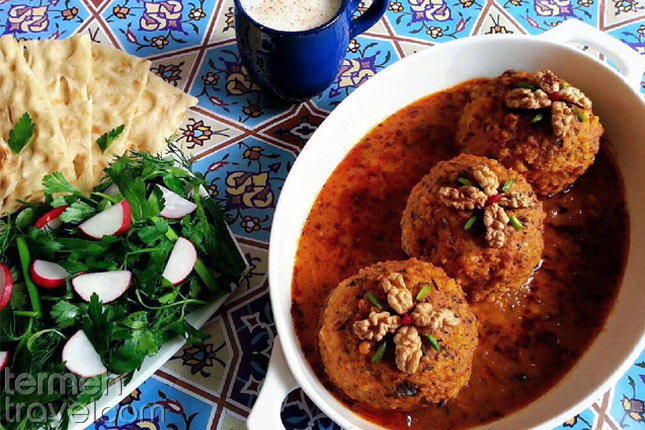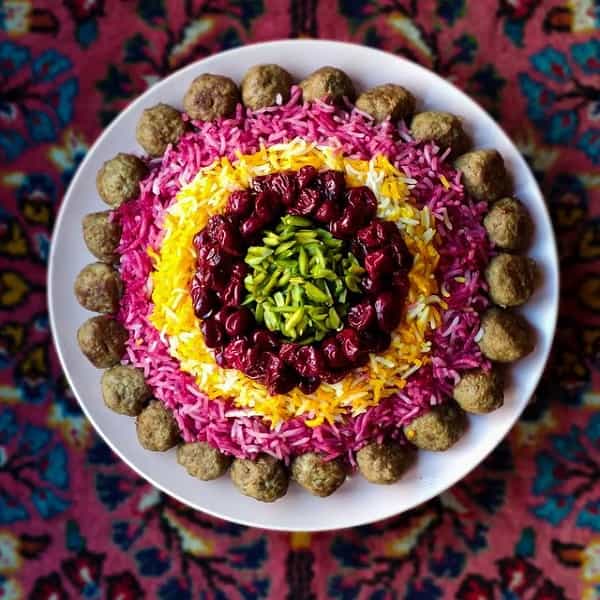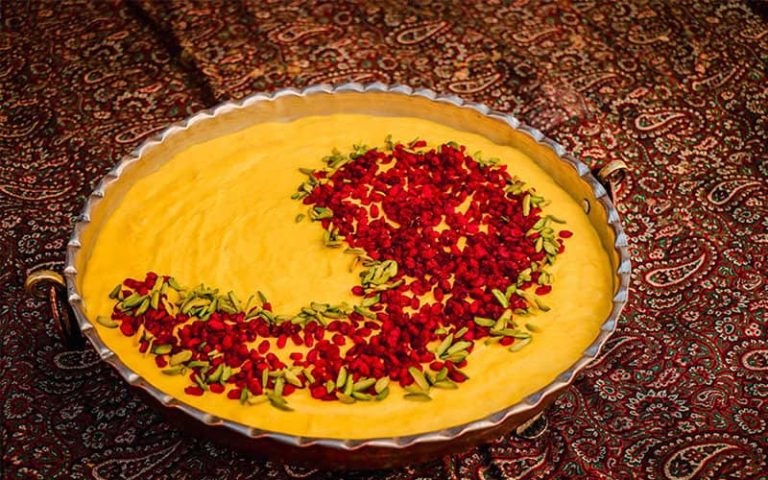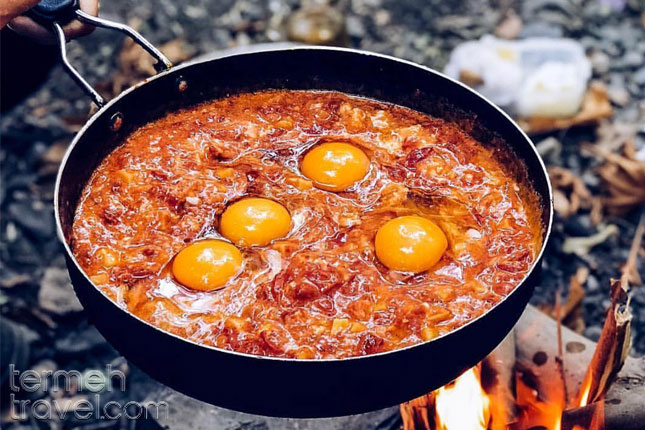Koofteh Tabrizi is one of the most difficult, yet delicious foods of Iranian Cuisine. The preparation takes time, the stuffings vary, and you need to practice the professional skill of making huge meatballs. The tomato sauce plays a crucial role in Koofteh Tabrizi and needs sensitive taste buds to perfect. You also need to know your way around rice and ground meat, and fresh or dried vegetables.
Tabriz is a rather cold city located in the northwest part of Iran. It is a historical city with lush nature, glorious mountains, and delicious foods. Most Tabriz-originated foods contain a hot bowl of soup or sauce to make the cold nights of East Azerbaijan warmer. Koofteh Tabrizi is no exception to this rule and has a delicious tomato and vegetable red sauce.
You can find Koofteh Tabrizi in the hospitable homes of Tabriz, most restaurants all over Iran, or if you read this article, in your own kitchen. I don’t promise an easy and straightforward recipe; the path to greatness is filled with thorns and needs patient wayfarers. Let’s dig into Persian deliciousness, with Koofteh Tabrizi, the complex Persian meatball.
What do you need to make Koofteh Tabrizi?
Meat:
The most significant ingredient in Koofteh Tabrizi is the meat. Koofteh Tabrizi must mostly taste like ground lamb meat and have a red color. It shouldn’t have too many vegetable pieces to make it look green and a taste like Koofteh Sabzi (Persian vegetable meatballs). Traditionally, skillful Persian chefs use a huge stone grinder to have sticky, mushed meat. This way of grinding meat will help the Koofteh shape and prevent it from falling apart.
If you don’t have access to a stone grinder, you can stimulate the process with your hands, kind of like kneading, to have a similar sticky, and mushed meat. You can also use a food processor for a few seconds, which gives you the same results. This sticky texture is very important, especially for big-sized meatballs, which will fall apart more quickly.
Rice:
Rice plays a crucial role in Persian cuisine. There is always a tray of white rice beside any Khoresht dish, decorated with saffron, barberries, and even sliced nuts. Rice is also used in making Iranian soups, puddings, and stews. Persian meatballs like Koofteh Tabrizi also contain a lot of rice in them, which creates a unique taste and texture in them.
You should soak the rice in cold water and salt before using it in the Koofteh Tabrizi mixture. You don’t need to cook it before making the meatballs, and the cooking process happens in the pot. If you want to make a more healthy dish, you can use brown rice instead of white rice, which is more nutritious.
Eggs:
Every meatball needs an element to stabilize its structure, and to prevent it from falling apart. We use raw, and ground hard-boiled eggs for the stabilization of Koofteh Tabrizi. It also helps with the taste and adds a somewhat creamy feeling to our dish. Eggs are one of the healthiest foods on the planet, and are so nutritious that they’re often referred to as “nature’s multivitamin.”
Vegetables, fruits, and legumes:
We need vegetables and fruits to lighten the taste and aroma of the Koofteh. Veggies will make our dish healthy, and give it a well-needed balance. Aromatic herbs like chives, dill, and savoy are going to battle the taste of ground meat. Tomato, potato, and onion each do their own job in the creation of this masterpiece, where split peas and chickpeas are the ones that help the uniqueness of the texture.
Dried Fruits and Nuts:
For the stuffing, we need sour, sweet, and crunchy elements. Dried fruits like plums, cherry plums, prunes, apricots, raisins, barberries, and dates take care of the sweet-sour taste. They preserve most of the nutrients found in fresh fruit, and are full of vitamins and minerals.
On the other hand, nuts like walnuts and almonds provide the crunchiness, as well as being super nutritious. You can even use some cashews, but it can’t be found in any traditional recipe.
Koofteh Tabrizi, The Complex Persian Meatball

Koofteh Tabrizi is one of the most difficult, yet delicious foods of Persian Cuisine. The preparation takes time, the stuffings vary, and you need to practice the professional skill of making huge meatballs. The tomato sauce plays a crucial role in Koofteh Tabrizi and needs sensitive taste buds to perfect. You also need to know your way around rice and ground meat, and fresh or dried vegetables.
- Ground lamb/beef (50/50 1 kg /1800 cal)
- Cooked and ground split peas 300 gr/ 889 cal
- Chives (dills, and savory 500 gr /150 cal)
- Cooked and pureed potato one large /283 cal
- Diced tomatoes 500 gr/ 90 cal
- Raw onion one large /60 cal
- Crispy fried onion 1-2 tbsp/ 10 cal
- Chickpea powder 1 tbsp/ 10 cal
- Skinned hard-boiled egg 1/ 78 cal
- Raw egg 1/ 72 cal
- Date 5-6/ 100 cal
- Rice 2 cups /432
- Walnuts 5-6 /185
- Unripe grapes or Verjuice ½ cup /20 cal
- Caraway 1 tsp
- Tomato paste 1 tbsp /13 cal
- Vegetable oil 2 tbsp/ 228 cal
- Salt (pepper, and saffron based on your taste)
- We use a rather large pot to make our sauce and will add meatballs to this mixture eventually.
- The stuffing will get ready in a pan (and we need a large bowl to combine and knead our mixture. Now let’s take a look at each process separately.)
- The Sauce
- First, we add diced tomatoes and oil to the pot on medium heat and saute to let the tomatoes release their tasty essence. Add the tomato paste and 4-5 cups of water and let it boil. You can also add fried onions and dried fruits to the sauce. The sauce also needs unripe grapes, but we only add those at the end of the cooking process.
- Finally, make the sauce tasty by adding your desired amount of salt, pepper, caraway, and saffron.
- The Stuffing
- The stuffing should be a fiesta of different tastes and textures. Dried plums, barberries, tomato paste, and unripe grapes are sour elements of the filling. Dates, dried apricots, and raisins are going to be the sweet factors, and walnuts are in charge of the crunchiness.
- Mix tomato paste into the mentioned ingredients above (whichever you prefer or have) and saute for 5 minutes with low heat. If your tomato paste is not salty, you can add some salt to it.
- Note: you should soak the dried fruits for at least a half-hour before adding to the mixture.
- The Koofteh Mixture
- In a big bowl, start kneading the ground meat until it gets sticky and thick. Then mix the ground meat with soaked rice, cooked and ground split peas, cooked and pureed potatoes, chives, dills, and savory, crispy fried onion, chickpea powder, hard-boiled ground egg, and a raw egg.
- Add saffron, salt, and pepper to the mixture.
- Forming Meatballs
- Now we need to choose our method. The more comfortable, less risky, and logical move is to make 5-6 meatballs the size of large grapefruits, or small melons. Take a generous amount of the mixture, form it into a thick disk, place a handful of stuffing in the middle of it, and try to make a meatball.
- Move your meatballs into the main pot and notice that the sauce should rise enough to cover half of the meatballs. It should cook for at least 2 hours, and hold its shape.
- The professional method, on the other hand, is to make a massive meatball. You need to be an experienced and skillful Persian grandmother or have a lot of courage and desire.
- If you are a risk-taker, continue reading.
- You need a fabric thick enough so that it can contain the meatballs without leaking, but thin enough to let the sauce do its magic. Put half of the Koofteh mixture inside this fabric and form a semi-sphere. Place your stuffing in the middle of that, and put the other half on top to create a full sphere.
- Move this carefully into the pot.
The Sauce
First, we add diced tomatoes and oil to the pot on medium heat and saute to let the tomatoes release their tasty essence. Add the tomato paste and 4-5 cups of water and let it boil. You can also add fried onions and dried fruits to the sauce. The sauce also needs unripe grapes, but we only add those at the end of the cooking process.
Finally, make the sauce tasty by adding your desired amount of salt, pepper, caraway, and saffron.
The Stuffing
The stuffing should be a fiesta of different tastes and textures. Dried plums, barberries, tomato paste, and unripe grapes are sour elements of the filling. Dates, dried apricots, and raisins are going to be the sweet factors, and walnuts are in charge of the crunchiness.
Mix tomato paste into the mentioned ingredients above (whichever you prefer or have) and saute for 5 minutes with low heat. If your tomato paste is not salty, you can add some salt to it.
Note: you should soak the dried fruits for at least a half-hour before adding to the mixture.
The Koofteh Mixture
In a big bowl, start kneading the ground meat until it gets sticky and thick. Then mix the ground meat with soaked rice, cooked and ground split peas, cooked and pureed potatoes, chives, dills, and savory, crispy fried onion, chickpea powder, hard-boiled ground egg, and a raw egg.
Add saffron, salt, and pepper to the mixture.
Forming Meatballs
Now we need to choose our method. The more comfortable, less risky, and logical move is to make 5-6 meatballs the size of large grapefruits, or small melons. Take a generous amount of the mixture, form it into a thick disk, place a handful of stuffing in the middle of it, and try to make a meatball.
Move your meatballs into the main pot and notice that the sauce should rise enough to cover half of the meatballs. It should cook for at least 2 hours, and hold its shape.
The professional method, on the other hand, is to make a massive meatball. You need to be an experienced and skillful Persian grandmother or have a lot of courage and desire.
If you are a risk-taker, continue reading.
You need a fabric thick enough so that it can contain the meatballs without leaking, but thin enough to let the sauce do its magic. Put half of the Koofteh mixture inside this fabric and form a semi-sphere. Place your stuffing in the middle of that, and put the other half on top to create a full sphere.
Move this carefully into the pot.
How to Make Vegetarian and Vegan Koofteh Tabrizi?
I know it’s not easy to make vegan Koofteh Tabrizi, but we’re going to try our best.
The process is the same, but we are going to replace the eggs and meat with chickpea powder, soybeans, or Tempe (traditional Indonesian soy product). For more information about vegan meatballs, I suggest visiting the Minimalistbaker website. For more traditional Iranian recipes visit Top Iranian Foods You Must Try.
















Wow! Amazing it was.
I do not know how to say how delicious it became when I made it with this recipe. I’m a student in Germany and I have always problems with these recipes, but this one made my last weekend a memorable one.
Thank you sooooooo much and looking forward to new recipes from you guys <3
Thank you so much for your nice words dear Hamed.
what do you do after putting the meatball(s) in the sauce?
how long?
serving?
Thank you for putting this delicious recipe out there. I have assembled all the nessesay ingredients minus the sour grape juice. I found one substitute on the internet which is white wine vinegar. Any thoughts on the amount required or do you recommend a different substitute? I was thinking about decreasing from 1/2 cup of sour grape juice to 1/3 cup white wine vinegar. Also 500 grams of chives,dill, and savory?
Regards
John Javad
You’re totally welcome ☺️.
Just add the vinegar slowly and taste to get your desired sourness. 👌🏻
Hi, this food belongs to Tabriz and Azerbaijani Turks of Iran. You’d better to use “Iranian” instead of Persian. Persian people are just a oart of Iranian population not all.